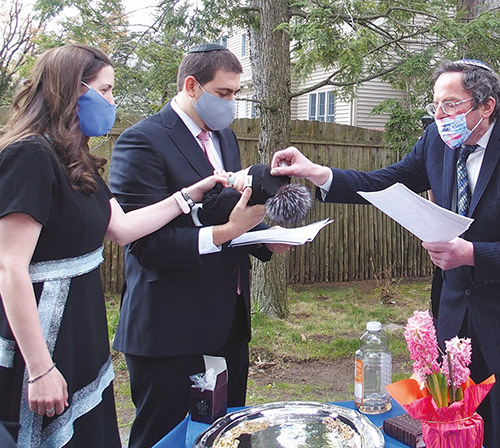


Gary Rosenberg is in great demand as a baal koreh, someone who reads the weekly Torah portion, in Englewood’s shuls and backyard minyanim. “I was first asked to lain in shul in 1980. As there are 54 parshas, I thought I’d add one a year and complete the Torah by 2030,” he said. “But over time, additional minyanim came into being in Englewood, and laining opportunities greatly increased, so I finished in 2016, 14 years ahead of schedule.”
This month he was recruited for an additional position: He served as the kohen for his great nephew’s pidyon ha’ben, the redemption of a son.
For a subset of firstborn baby boys, there’s one more ceremony after the bris. On the baby’s 31st day, if he was delivered naturally, and is not the son of a kohen or levite, or son of a bat kohen or bat levi, daughter of a kohen or a levite, he has to be redeemed with five coins of pure silver, given to a kohen. About one in 10 Jewish families meet the criteria, according to Rabbi Shraga Simmons writing in Aish.com.
The coins are obtained in a variety of ways. They can be purchased through Judaica stores at the cost of hundreds of dollars. Many kohanim keep them and lend them to friends and others through word of mouth. Some Jewish communities have a gemach that lends coins. To be valid, there is a transaction involved. Often, couples borrow the coins and pay a fee to the gemach or kohen.
The origins of the ceremony go way back. As Gary explained, with help from Wikipedia and additional sources, the codification appears, among other places in the Torah, in Numbers 3: 12-13: “…I have taken the Levites from among the children of Israel instead of every firstborn that openeth the womb among the children of Israel; and the Levites shall be Mine; for all the first-born are Mine: on the day that I smote all the first-born in the land of Egypt I hallowed unto Me all the first-born in Israel, both man and beast, Mine they shall be: I am the Lord.”
Thus, the responsibilities of the firstborn were derived from having been spared in the tenth plague. After the sin of the golden calf, when the Levites joined Moses against those involved in the sin, they replaced the first-born as those who would be involved in the Temple service, and the priesthood was given to the kohanim—Aaron and his male descendants. However, the firstborn of each non-levite family had to be redeemed, or bought back, from the dedication to Hashem that would previously have been required of him.
By custom, the baby is brought to the kohen literally on a silver platter. There is also a minhag for the women to put their jewelry on the platter, recalling that the women did not contribute their jewelry to make the golden calf. Another custom is to include sugar cubes, in hopes of a sweet future, and garlic cloves to protect against evil spirits.
The father declares that his son is the first born of the mother, and then the kohen asks the critical question: “Do you want to redeem your son?” Gary recalled his first experience serving as the kohen for a pidyon ha’ben. He posed the question to the baby’s father, his nephew, and the baby began to wail. “Don’t worry,” the father said, “I’m going to keep you!” This is in fact a rhetorical question, as Halacha requires the father to answer in the affirmative. He recites two blessings, one for the pidyon and a shehecheyanu, and hands the five silver coins to the kohen.
The kohen confirms the redemption by holding the coins over the baby’s head, much like the kapparos at Yom Kippur, and states that the exchange is complete. He adds that the boy should grow to Torah, chuppah and good deeds. He then puts his right hand on the baby’s head in the Ashkenazic traditional priestly position of leaving a space between the thumb and the forefinger and between the middle fingers. As most “Star Trek” fans know, that gesture was incorporated into the Vulcan proverb that would also be appropriate here: “Live long and prosper.”
The kohen recites the blessing used in the synagogue during Duchening, as well as several biblical verses that add wishes for the baby’s well-being throughout his life. He then makes the bracha over a cup of grape juice, which he drinks. There are some differences in the liturgy between various texts. Gary drew upon his brother-in-law’s German custom siddur and an ArtScroll siddur.
In pre-COVID times, each pidyon was followed by a festive meal, a seudas mitzvah, similar to a bris. This pidyon ha’ben was held in the baby’s great-grandmother’s backyard with a small number of family members. Boxed meals, including pouches of garlic and sugar cubes, were handed to the guests as they left.
Gary said he enjoys the special responsibilities that come with being a Kohen and would be happy to perform the pidyon ha’ben ceremony for other families. It’s also much less work than being a baal koreh.
By Bracha Schwartz













